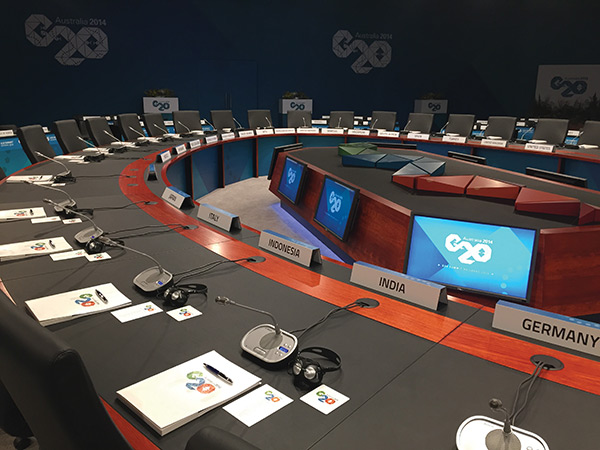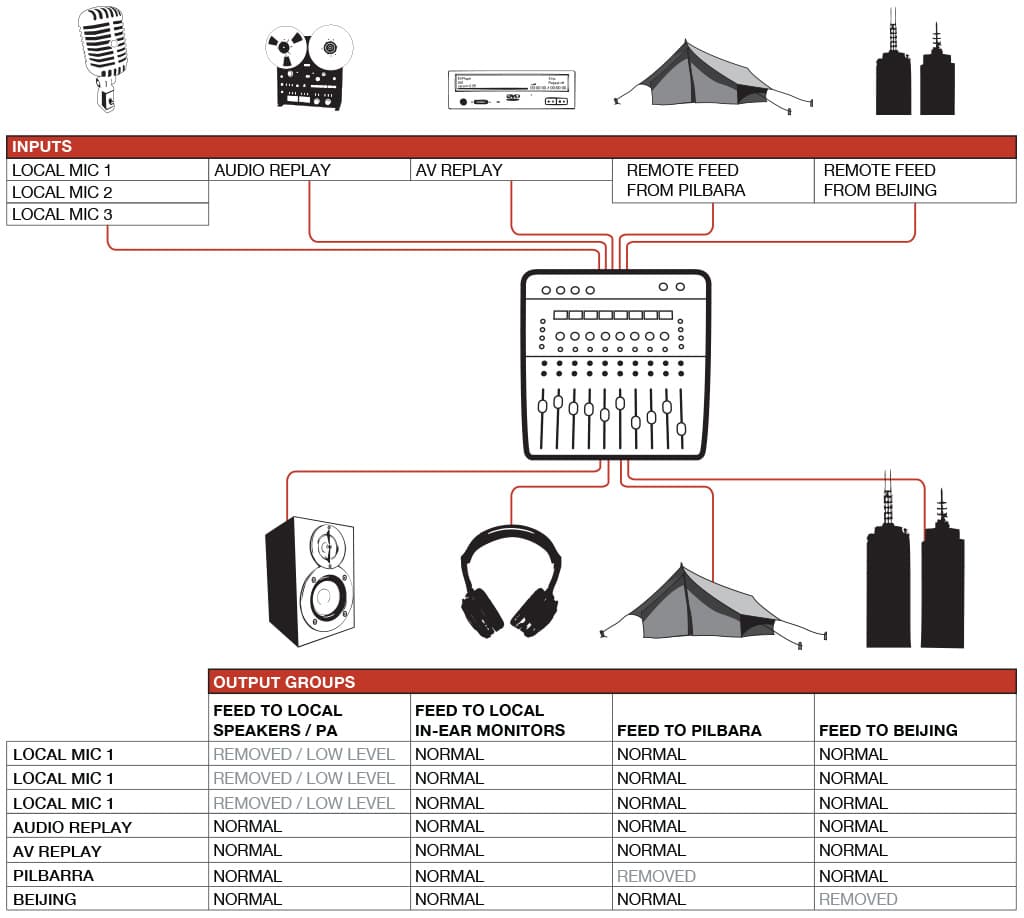
Where Less is More
Mix Minus, Clean Feed, Return Audio… call it what you will, but a successful conference call can be doomed without it.
Text:/ Gep Blake
A second feels like an hour. Sweat drips from your palms into the console as the entire board of executives sits patiently in the boardroom of Particularly Important Inc, looking up at the video conference screen: waiting for their esteemed colleague in Beijing to respond to the critical question put to her by the company president. You’ve checked everything before the meeting. You’ve heard the operator at the other end recite “Mary had a little lamb” in Mandarin. PA and mics all working at your end. Levels are good. Should be okay…. She smiles, nods, opens her mouth, gets about one and a half words out and starts to speak in slow motion, all the while gesticulating madly at her ear saying “sorry, I – seem – to – be – hearing – myself – back – a – bit – delayed…”
Hearing your remote guests is only half the story. They need to hear you without extraneous distracting sound. That’s where a mix minus comes in.
Mix minus audio, as the name suggests, is an audio feed that consists of a full mix of all program sound minus some elements – usually the source to which it is being fed. For example, if the mix minus had been set up properly for our friend in Beijing, she would hear everything in the conference room – attendees’ microphones, tape replays, etc, but not herself.
KEEP IT CLEAN
A mix minus is also referred to as return audio or a clean feed. This shouldn’t be confused with Interruptible Fold Back (IFB). In my experience, there’s no hard and fast rule about which term to use — particular terms often become part of the local parlance within a given organisation or region.
Mix minus is the term I have heard most commonly used in Australia, but broadcast professionals will generally understand what you’re talking about if you refer to clean feed audio or return audio. Because as operators we’re always in a desperate hurry, the word ‘audio’ will often get dropped to save us thirty milliseconds, but to avoid confusion, get in the habit of specifying whether you’re talking about audio or vision.
To nail down the distinction, IFB is foldback that is provided to remote reporters; studio presenters; commentators or even operators. The audio in an IFB will usually be a mix minus, via an earpiece and the clever part is that it can be ‘interrupted’ by a director, producer or anyone appropriate, keying on a talkback panel. The purpose of IFB is to give directions or updated information to the person receiving it, with minimal intrusion on the performance. There is an obvious danger of distracting the on-air talent, so if you are ever using IFB, keep in mind the bod at the other end is already splitting their attention and trying to appear authoritative/compassionate/fun/knowledgeable (depending on the situation), so interrupt sparingly!

THE SETUP
The ease of arranging a mix minus is dependent on how comprehensive your audio setup is. Some broadcast consoles have a dedicated clean feed output bus, which obviously makes things very straight forward. Generally, however, the easiest way is to use an available group output. Simply select each source that you want on the group output that you’ve chosen, leaving out (minus-ing) the remote guest to whom the mix minus is being sent. If you’re using less sophisticated gear, you could use auxiliary or effects sends, but that will take a lot more setting up and starts to get pretty confusing, particularly if you have more than one remote guest.
Generally it’s best to go post fader, as the guest will usually only be interested in hearing the main program sound and you reduce the danger of them hearing tapes cueing or other spurious material. In situations where a full two-way audio path isn’t available, the most common way for the audio to get back to the remote guest is via a Telephone Recorder Interface (TRI). This device will send your mix minus audio down a phone line to the remote location, where another TRI will decode the phone signal for use as normal audio.
DON’T DELAY
The main problems are nothing new to AV operators – unwanted delay and feedback. Any transmission medium will introduce some delay, and that will obviously vary considerably according to the length and latency of the signal path. If the audio of the guest in Beijing strays into an open microphone in your boardroom, that sound will then be sent down the mix minus, with the delay from the original signal (Beijing to boardroom) plus the delay from the return path (boardroom to Beijing). Suddenly our colleague is hearing herself in her ear, half a second after she speaks. Most disconcerting! Worse still, if the audio then leaks back to the main signal in Beijing, we have a feedback loop of global proportions.
LOW LEVEL
There’s only one failsafe solution, and that’s to use earpieces at both ends to isolate all the audio. This is usually what happens in broadcast situations, and if it can be done this way, do it! However, it can be difficult or impossible to give earpieces to a large group – a big board of directors or an audience, for example.
If you have to use sound reinforcement there are a few things you can do. Firstly, make sure the audio of the guest is as low as it can be; if possible use many smaller speakers at low level, closer to the listeners rather than big cabinets. Secondly, ride the levels as much as possible. Using our example again, if the boardroom mics are down when our guest is speaking, they’re less likely to pick up her audio, and vice versa. Finally, if these options just aren’t open to you and you’re prepared to lose a bit of sound quality, there’s the technological solution: echo cancelling.
So, to sign off, there is no one-size-fits-all solution, but the important principles to keep in mind with a mix minus are:
Remote locations receive all program audio except themselves.
Isolate program and return audio signals – if possible through the use of earpieces, or at least through minimal PA and riding levels.















RESPONSES